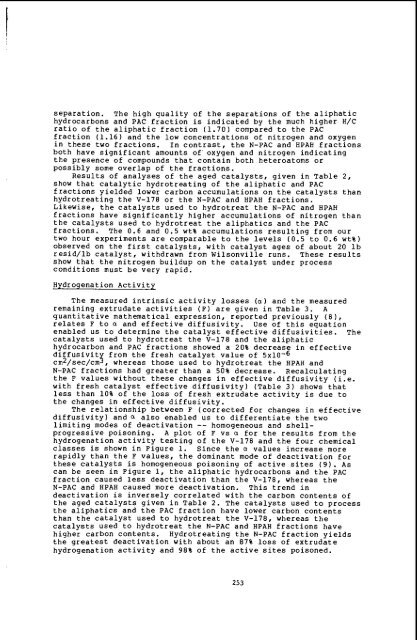Liquefaction co-processing of coal shale oil at - Argonne National ...
Liquefaction co-processing of coal shale oil at - Argonne National ...
Liquefaction co-processing of coal shale oil at - Argonne National ...
You also want an ePaper? Increase the reach of your titles
YUMPU automatically turns print PDFs into web optimized ePapers that Google loves.
separ<strong>at</strong>ion. The high quality <strong>of</strong> the separ<strong>at</strong>ions <strong>of</strong> the aliph<strong>at</strong>ic<br />
hydrocarbons and PAC fraction is indic<strong>at</strong>ed by the much higher H/C<br />
r<strong>at</strong>io <strong>of</strong> the aliph<strong>at</strong>ic fraction (1.70) <strong>co</strong>mpared to the PAC<br />
fraction (1.16) and the low <strong>co</strong>ncentr<strong>at</strong>ions <strong>of</strong> nitrogen and oxygen<br />
in these two fractions. In <strong>co</strong>ntrast, the N-PAC and HPAH fractions<br />
both have significant amounts <strong>of</strong>' oxygen and nitrogen indic<strong>at</strong>ing<br />
the presence <strong>of</strong> <strong>co</strong>mpounds th<strong>at</strong> <strong>co</strong>ntain both hetero<strong>at</strong>oms or<br />
possibly some overlap <strong>of</strong> the fractions.<br />
Results <strong>of</strong> analyses <strong>of</strong> the aged c<strong>at</strong>alysts, given in Table 2,<br />
show th<strong>at</strong> c<strong>at</strong>alytic hydrotre<strong>at</strong>ing <strong>of</strong> the aliph<strong>at</strong>ic and PAC<br />
fractions yielded lower carbon accumul<strong>at</strong>ions on the c<strong>at</strong>alysts than<br />
hydrotre<strong>at</strong>ing the V-178 or the N-PAC and HPAH fractions.<br />
Likewise, the c<strong>at</strong>alysts used to hydrotre<strong>at</strong> the N-PAC and HPAH<br />
fractions have significantly higher accumul<strong>at</strong>ions <strong>of</strong> nitrogen than<br />
the c<strong>at</strong>alysts used to hydrotre<strong>at</strong> the aliph<strong>at</strong>ics and the PAC<br />
fractions. The 0.6 and 0.5 wt% accumul<strong>at</strong>ions resulting from our<br />
two hour experiments are <strong>co</strong>mparable to the levels (0.5 to 0.6 wt%)<br />
observed on the first c<strong>at</strong>alysts, with c<strong>at</strong>alyst ages <strong>of</strong> about 20 lb<br />
resid/lb c<strong>at</strong>alyst, withdrawn from Wilsonville runs. These results<br />
show th<strong>at</strong> the nitrogen buildup on the c<strong>at</strong>alyst under process<br />
<strong>co</strong>nditions must be very rapid.<br />
Hydrogen<strong>at</strong>ion Activity<br />
The measured intrinsic activity losses (a) and the measured<br />
remaining extrud<strong>at</strong>e activities (F) are given in Table 3. A<br />
quantit<strong>at</strong>ive m<strong>at</strong>hem<strong>at</strong>ical expression, reported previously (E),<br />
rel<strong>at</strong>es F to a and effective diffusivity. Use <strong>of</strong> this equ<strong>at</strong>ion<br />
enabled us to determine the c<strong>at</strong>alyst effective diffusivities. The<br />
c<strong>at</strong>alysts used to hydrotre<strong>at</strong> the V-178 and the aliph<strong>at</strong>ic<br />
hydrocarbon and PAC fractions showed a 20% decrease in effective<br />
diffusivit from the fresh c<strong>at</strong>alyst value <strong>of</strong> 5x10-6<br />
cm2/sec/cm3, whereas those used to hydrotre<strong>at</strong> the HPAH and<br />
N-PAC fractions had gre<strong>at</strong>er than a 50% decrease. Recalcul<strong>at</strong>ing<br />
the F values without these changes in effective diffusivity (i.e.<br />
with fresh c<strong>at</strong>alyst effective diffusivity) (Table 3 ) shows th<strong>at</strong><br />
less than 10% <strong>of</strong> the loss <strong>of</strong> fresh extrud<strong>at</strong>e activity is due to<br />
the changes in effective diffusivity.<br />
The rel<strong>at</strong>ionship between F (<strong>co</strong>rrected for changes in effective<br />
diffusivity) and a also enabled us to differenti<strong>at</strong>e the two<br />
limiting modes <strong>of</strong> deactiv<strong>at</strong>ion -- homogeneous and shell-<br />
progressive poisoning. A plot <strong>of</strong> F vs a for the results from the<br />
hydrogen<strong>at</strong>ion activity testing <strong>of</strong> the V-178 and the four chemical<br />
classes is shown in Figure 1. Since the a values increase more<br />
rapidly than the F values, the dominant mode <strong>of</strong> deactiv<strong>at</strong>ion for<br />
these c<strong>at</strong>alysts is homogeneous poisoning <strong>of</strong> active sites (9). As<br />
can be seen in Figure 1, the aliph<strong>at</strong>ic hydrocarbons and the PAC<br />
fraction caused less deactiv<strong>at</strong>ion than the V-178, whereas the<br />
N-PAC and HPAH caused more deactiv<strong>at</strong>ion. This trend in<br />
deactiv<strong>at</strong>ion is inversely <strong>co</strong>rrel<strong>at</strong>ed with the carbon <strong>co</strong>ntents <strong>of</strong><br />
the aged c<strong>at</strong>alysts given in Table 2. The c<strong>at</strong>alysts used to process<br />
the aliph<strong>at</strong>ics and the PAC fraction have lower carbon <strong>co</strong>ntents<br />
than the c<strong>at</strong>alyst used to hydrotre<strong>at</strong> the V-178, whereas the<br />
c<strong>at</strong>alysts used to hydrotre<strong>at</strong> the N-PAC and HPAH fractions have<br />
higher carbon <strong>co</strong>ntents. Hydrotre<strong>at</strong>ing the N-PAC fraction yields<br />
the gre<strong>at</strong>est deactiv<strong>at</strong>ion with about an 87% loss <strong>of</strong> extrud<strong>at</strong>e<br />
hydrogen<strong>at</strong>ion activity and 98% <strong>of</strong> the active sites poisoned.<br />
253

















